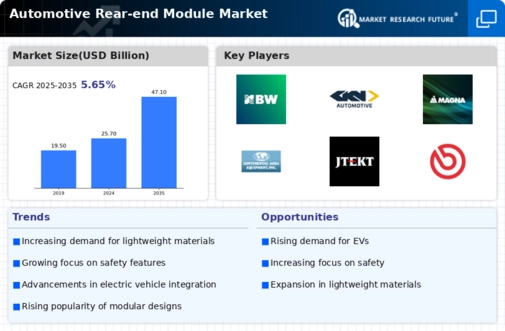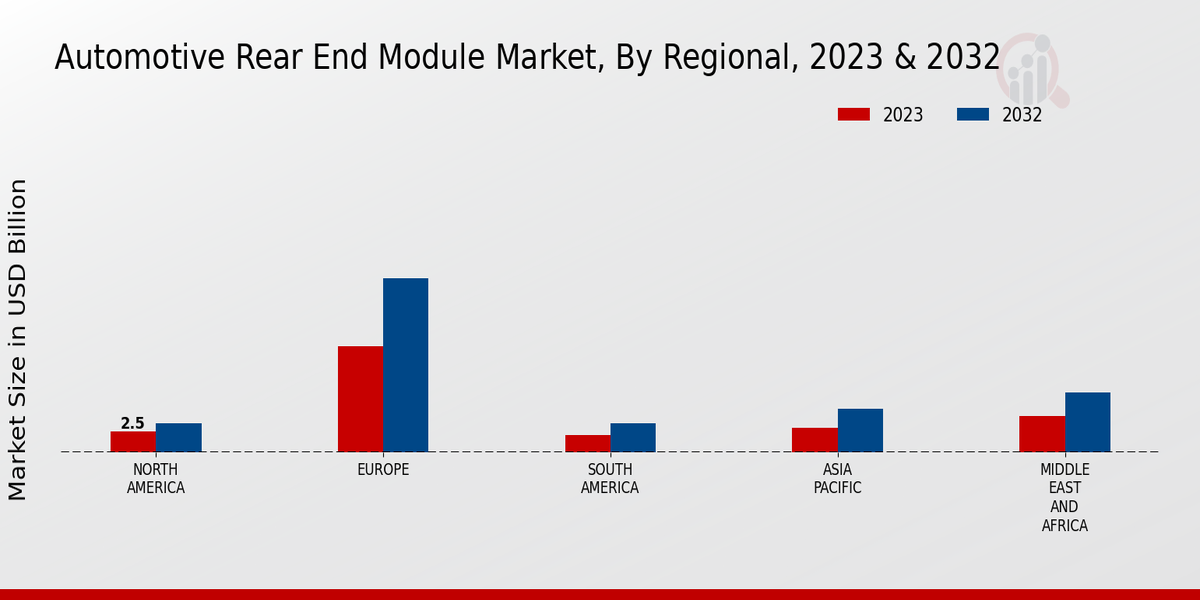Market Growth Projection
The Global Automotive Rear-end Module Market Industry is poised for substantial growth, with projections indicating a market size of 25.7 USD Billion in 2024 and an anticipated increase to 47.1 USD Billion by 2035. This growth trajectory suggests a compound annual growth rate of 5.65% from 2025 to 2035. Such figures underscore the increasing demand for advanced automotive solutions and the industry's response to evolving consumer preferences and regulatory requirements. The market's expansion is likely to be fueled by innovations in design, materials, and technology, positioning it as a dynamic sector within the broader automotive landscape.
Rising Focus on Safety Standards
The heightened emphasis on safety regulations significantly influences the Global Automotive Rear-end Module Market Industry. Governments and regulatory bodies are continuously updating safety standards to ensure consumer protection. This trend compels manufacturers to enhance the structural integrity and crashworthiness of rear-end modules. For instance, the implementation of stringent crash test requirements necessitates the use of advanced engineering techniques and materials. As a result, the market is likely to expand as automotive companies invest in research and development to meet these evolving safety standards, thereby fostering consumer confidence and driving sales.
Growing Demand for Electric Vehicles
The increasing consumer preference for electric vehicles is a pivotal driver in the Global Automotive Rear-end Module Market Industry. As governments worldwide implement stricter emissions regulations, the shift towards electric mobility accelerates. This transition necessitates the development of advanced rear-end modules that accommodate electric drivetrains and battery systems. In 2024, the market is projected to reach 25.7 USD Billion, reflecting the growing integration of innovative technologies in automotive design. Manufacturers are investing in lightweight materials and modular designs to enhance efficiency, which could further propel market growth as electric vehicle adoption continues to rise.
Increasing Urbanization and Vehicle Ownership
Urbanization trends and rising vehicle ownership rates are key factors driving the Global Automotive Rear-end Module Market Industry. As populations in urban areas grow, the demand for personal transportation increases, leading to higher vehicle production. This surge in vehicle ownership necessitates the development of efficient rear-end modules that can accommodate diverse vehicle types. In 2035, the market is anticipated to reach 47.1 USD Billion, reflecting the growing need for innovative automotive solutions. Manufacturers are responding by designing rear-end modules that optimize space and functionality, catering to the evolving preferences of urban consumers.
Technological Advancements in Automotive Design
Technological innovations play a crucial role in shaping the Global Automotive Rear-end Module Market Industry. The integration of advanced materials, such as carbon fiber and high-strength steel, enhances the performance and safety of rear-end modules. Furthermore, the incorporation of smart technologies, including sensors and connectivity features, is becoming increasingly prevalent. These advancements not only improve vehicle safety but also contribute to weight reduction and fuel efficiency. As the automotive industry embraces these technologies, the market is expected to witness a compound annual growth rate of 5.65% from 2025 to 2035, indicating a robust trajectory for the future.
Sustainability Initiatives in Automotive Manufacturing
Sustainability initiatives are becoming increasingly vital in the Global Automotive Rear-end Module Market Industry. As environmental concerns rise, manufacturers are adopting eco-friendly practices in production processes. This includes utilizing recyclable materials and implementing energy-efficient manufacturing techniques. Such initiatives not only reduce the carbon footprint but also align with consumer expectations for sustainable products. The market is likely to benefit from this shift as companies that prioritize sustainability gain a competitive edge. This trend may also attract investments from environmentally conscious consumers, further driving market growth.






















